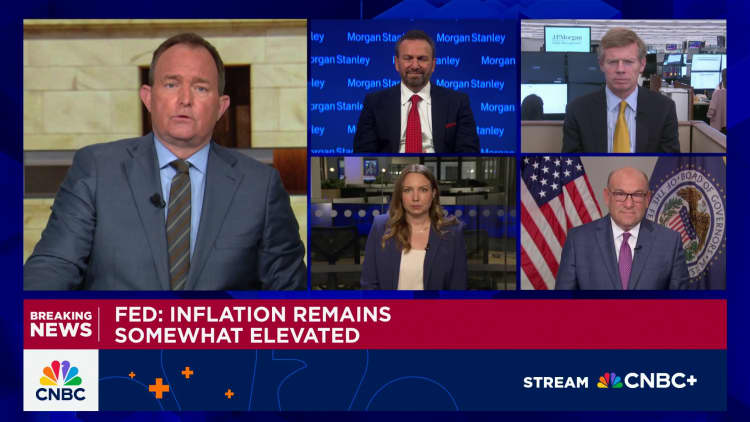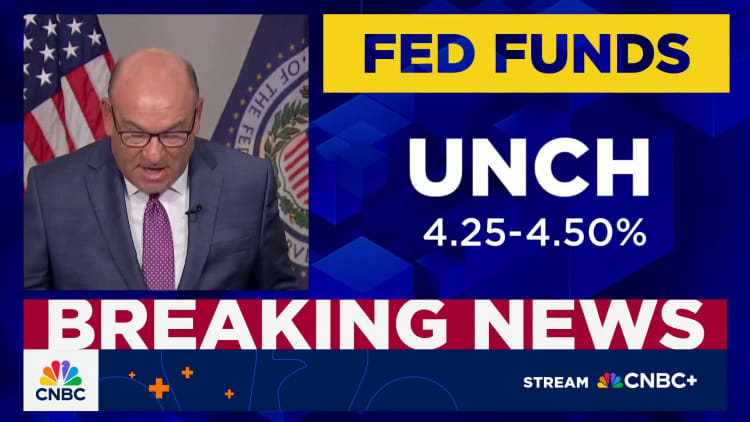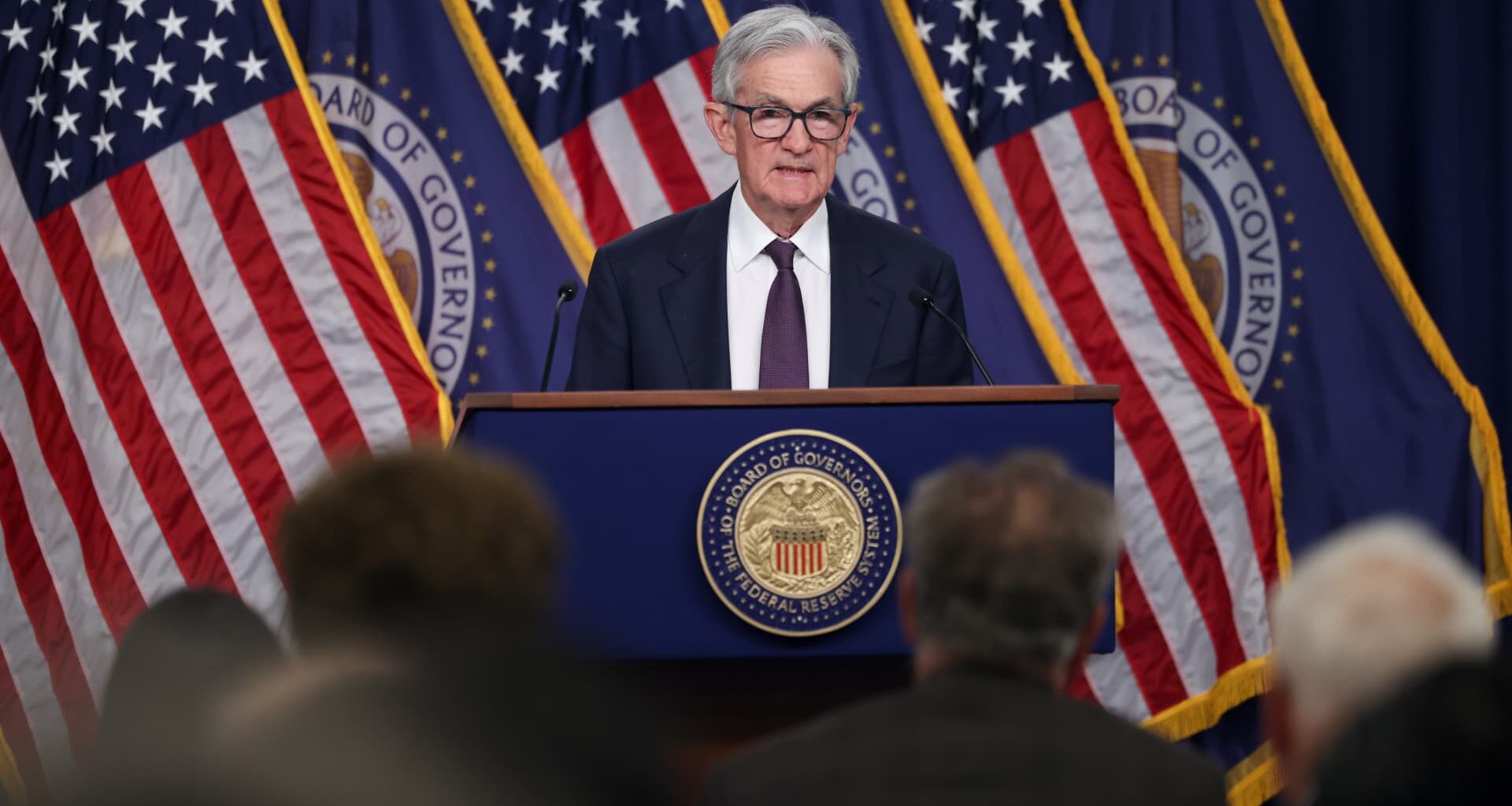While speaking about the sustained strength in the labor market, Powell added that he sees no signs in the near term that the U.S. economy will weaken.
“The U.S. economy has defied all kinds of forecasts for it to weaken, really over the last three years, and it’s been remarkable to see … again and again when people think it’s going to weaken out. Eventually it will, but we don’t see signs of that now,” he said.
— Lisa Kailai Han
Federal Reserve Chair Powell said on Wednesday that tariffs are an unavoidable cost increase to businesses and consumers.
“Everyone that I know is forecasting a meaningful increase in inflation in coming months from tariffs because someone has to pay for the tariffs,” Powell said. “It will be someone in that chain that I mentioned, between the manufacturer, the exporter, the importer, the retailer, ultimately somebody putting it into a good of some kind or just the consumer buying it.”
“All through that chain, people will be trying not to be the ones who can take up the cost but ultimately, the cost of the tariff has to be paid. And some of it will fall on the end consumer.”
— Brian Evans
Byron Anderson, head of fixed income at Laffer Tengler Investments, said the Federal Reserve is likely making a trade-off when it comes to keeping tariff inflation low.
In emailed comments, Anderson wrote that the Fed’s decision to keep interest rates unchanged on Wednesday was unsurprising.
“The Fed has flipped from a long-term data stance when inflation was raging, to this short-term data focus toward rising inflation, as we are seeing cracks in soft data coming from growth, consumers, labor markets, and housing,” he said. “The Fed seems obsessed with tariff inflation and are willing to sacrifice employment and GDP growth before adjusting this stance.”
Anderson added: “CPI and PCE should see further disinflation from housing over the next year as inventories continue to increase and prices start to decrease.”
— Lisa Kailai Han
Fed Chair Powell said the “dot plot” should be interpreted with a grain of salt as the macroeconomic environment remains highly risky.
“I think what you see people doing is looking ahead at a time of very high uncertainty and writing down what they think the most likely case is. No one holds these rate paths with a great deal of conviction, and everyone would agree that they’re all going to be data dependent,” Powell said.
The projection reflects 19 individual members’ expectations for rates, and it indicates an expectation of two rate reductions this year.
— Yun Li
The U.S. economy has not yet seen the full effect of tariffs on prices for consumers, Fed Chair Powell said.
“It takes some time for tariffs to work their way through the chain of distribution to the end consumer. A good example of that would be goods being sold at retailers today may have been imported several months ago before tariffs were imposed. So we’re beginning to see some effects, and we do expect to see more of them over the coming months,” he said.
— Jesse Pound
With a bevy of economic variables still unsettled, Fed Chair Powell said the central bank is content to sit tight until it learns more.
“For the time being, we are well positioned to wait to learn more about the likely course of the economy before considering any adjustments to our policies,” Powell said at his post-meeting news conference.
Powell noted that Trump’s tariffs have the potential both to cause one-time price increases that the Fed likely would look through, or a longer-lasting hit to inflation.
— Jeff Cox
Fed Chair Powell highlighted a recent uptick in inflation expectations in his opening remarks and said that trend may be tied to tariffs.
“Near-term measures of inflation expectations have moved up over recent months, as reflected in both market and survey-based measures. Respondents to surveys of consumers, businesses and professional forecasters point to tariffs as the driving factor. Beyond the next year or so, however, most measures of longer-term expectations remain consistent with our 2% inflation goal,” Powell said.
— Jesse Pound
The Federal Reserve’s meeting had a dovish tone, with expectations for two rate cuts still in place for this year despite upward revisions to near-term inflation forecasts, said Simon Dangoor, head of fixed income macro strategies at Goldman Sachs Asset Management.
“Implicitly, FOMC members continue to expect stronger near-term inflation to prove largely transitory and their tolerance to upward moves in unemployment remains low,” he said. “We expect the Fed to remain on hold at next month’s meeting but think a path could open up to a resumption of its easing cycle later this year should the labor market weaken.”
— Michelle Fox

The big news from the Federal Reserve’s meeting is the increase in the number of members that don’t want to cut interest rates this year, said Jim Caron, chief investment officer for the portfolio solutions group at Morgan Stanley Investment Management.
“We went from four people calling for no rate cuts to now seven people calling for no rate cuts,” he said on “Power Lunch.”
“We’re moving towards a no-rate-cut environment going forward,” he added.
— Michelle Fox
The Federal Reserve could wind up holding interest rates steady through the end of this year, said David Kelly, JPMorgan Asset Management chief global strategist.
If the inflation is expected to go up due to tariffs, it will fade by 2026, he noted.
“Even if you get a sugar rush from fiscal stimulus, from this bill going through Congress, that sugar rush will fade. Sugar rushes do,” Kelly said in an interview with CNBC’s “Power Lunch.”
“By the end of the next year, the economy should be cooling down. Inflation should be cooling down, and maybe then they can give us some lower rates,” he said. “Right now, do not hold your breath waiting for low rates from the Federal Reserve because they don’t seem to have any intention of delivering them.”
— Michelle Fox
The three major averages kept their gains on the session following the Federal Reserve’s move to keep rates steady.
At 2:20 p.m. ET, the S&P 500 was up 0.27%, while the Nasdaq Composite rose 0.38%. The Dow Jones Industrial Average added 106 points, or 0.25%.
— Darla Mercado
The Federal Reserve has released its statement for the June meeting. Click here to see how it compares to the release from the May gathering.
— Alex Harring
The federal funds rate sets what banks charge one another for overnight lending, but also has a domino effect on almost all of the borrowing and savings rates Americans see every day.
The Fed’s decision to hold rates steady means “borrowing rates are high, with mortgage rates near 7%, many home equity lines of credit in double-digit interest rate territory, and the average credit card rate still above 20%,” said Greg McBride, chief financial analyst at Bankrate. “But savers continue to be rewarded with inflation-beating returns on the top-yielding savings accounts, money market accounts, and certificates of deposit.”
From credit cards and mortgage rates to auto loans and savings accounts, here is a breakdown of all the ways the Fed’s moves influence your wallet.
— Jessica Dickler

Stocks were modestly higher across the board just prior to the Fed’s rate announcement.
The Dow Jones Industrial Average was up 150 points, or 0.35%. The S&P 500 was toting a 0.37% gain, and the Nasdaq Composite was up 0.48%.
— Darla Mercado
As the Federal Reserve’s rate decision neared, Trump critiqued Chair Jerome Powell, calling him “stupid.”
Speaking outside the White House on Wednesday morning, Trump said he didn’t expect central bank policymakers to cut rates at the conclusion of their June meeting.
“So we have a stupid person,” Trump said of Powell. “Frankly, you probably won’t cut today.”
“Europe had 10 cuts, and we had none. And I guess he’s a political guy, I don’t know. He’s a political guy who’s not a smart person, but he’s costing the country a fortune,” Trump said.
Fed funds futures trading suggests the Federal Reserve will likely stand pat on rates Wednesday, keeping them at the target range of 4.25% to 4.5%.
Read more from CNBC’s Jeff Cox on Trump’s comments over rate policy here.
— Darla Mercado
The Federal Reserve’s outlook could be the big market-moving development on Wednesday.
Policymakers are widely expected to hold interest rates steady at the conclusion of their June meeting, but traders are eager to hear their latest outlook on the path forward for rates.
The Federal Open Market Committee will be issuing its Summary of Economic Projections, which includes policymakers’ forecasts on inflation, economic growth and the unemployment rate. The Fed’s closely followed “dot plot” is also part of the outlook, showing FOMC members’ projections for interest rates.
The forecast comes at a critical time for the U.S. economy, which is grappling with uncertainty around President Donald Trump’s tariff policy, mixed economic data and now a conflict between Israel and Iran that is pushing energy prices higher.
Read more from CNBC’s Jeff Cox on what to expect from the Fed on Wednesday.
— Darla Mercado
The Federal Reserve is largely expected to stay put on interest rates, maintaining them at a target range of 4.25% to 4.5%, which is where they’ve been since December.
Even as rates are off their highs and the Fed put through three cuts in late 2024, borrowing costs remain relatively high for consumers.
During the week of June 13, rates on 30-year fixed mortgages are at 6.89%, according to MND. That’s up from 4.29% during the week of March 11, 2022 — just before the Fed embarked on its rate-hiking campaign. Home equity loan rates are also high, sitting at 8.4% as of June 13, compared to 5.96% in March 2022, per Bankrate.
Credit card borrowers are also paying more on their balances, with rates hovering at 20.12%, per Bankrate. That’s up from 16.34% in March 2022.
Higher rates have been good news for savers, however. Yields on money market funds were at 0.44% as of June 13, compared to 0.08% in March 2022, according to Haver. Five-year certificates of deposit have seen their annual percentage yields rise to 1.71% as of June 13, up from 0.50% in March 2022, Haver found.
— Darla Mercado, Nick Wells
